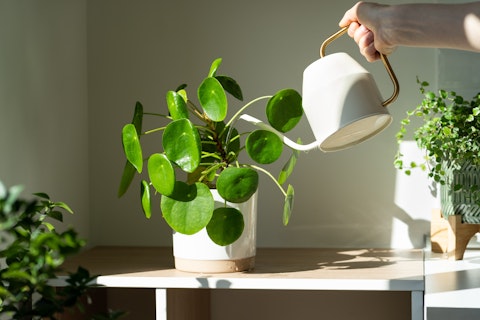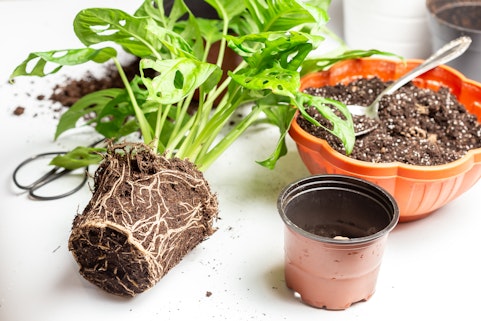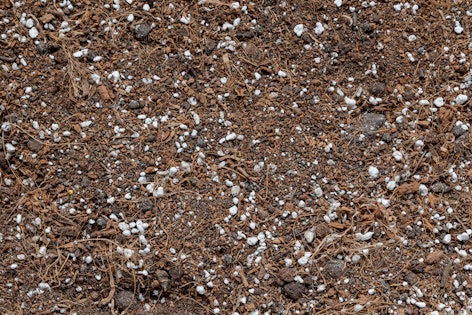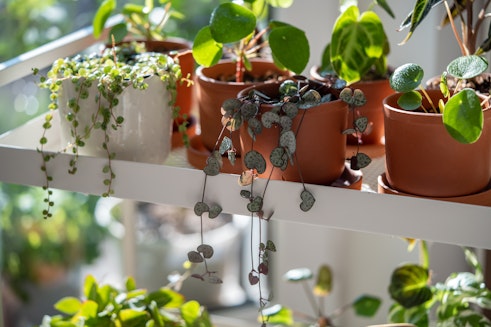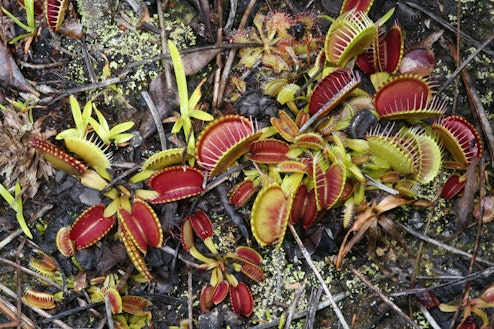
- Home
- Propagating Plants - Making new plants from the ones you have already
General Houseplant Care
Propagating Plants - Making new plants from the ones you have already
24th April 2024
Jonathan Davies
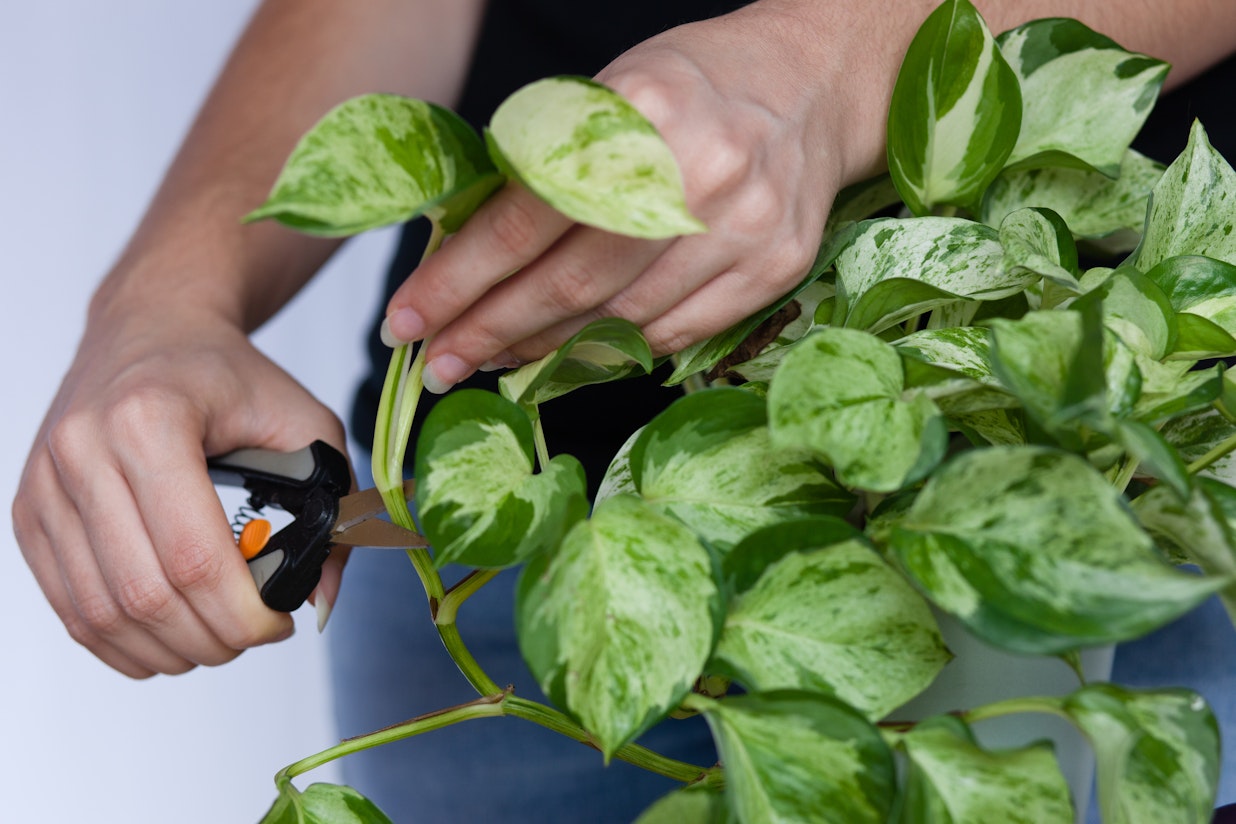
We all remember the rumour about worms, I'm sure you know the one: If you cut a worm in half, you’ll get two worms! Well… as it turns out, this is only partially true for worms. But it is true for plants! They really are the gift that keeps on giving, and with the right knowledge and attention, one plant can very easily turn into 10, and 10 into 100 and so on! However, before you start chopping up your plants, there are one or two things you need to know about propagation.
Propagation, by definition, is the act of reproducing or breeding a living thing by means of natural processes using the parent stock. This means that the term itself, when applied to plants, encompasses everything from planting seeds to rooting cuttings!
Taking Cuttings
Cuttings are a small segment of a parent plant that are taken with the intention of producing another plant from them. Unfortunately, not all plants can be cut to provide a second plant, nor are all cuttings automatically successful. Propagation from cuttings hasn’t got a 100% success rate, even when done correctly. But for the best chance, here are a few things to keep in mind:
Health: It is important to take cuttings from a healthy plant. If a plant is struggling, or showing any signs of stress, the likelihood that the cutting will be successful is reduced. Not to say that it is impossible, sometimes propagating a cutting can be a good last ditch effort to save a perpetually suffering plant! If given a choice, take cuttings from the healthiest plant, or at least the healthiest part of a plant.
Maturity: An older and larger, well established plant is more likely to produce successful cuttings. Young plants are less developed and more susceptible to problems that can arise from being cut or damaged in any way. Further, taking a cutting from a smaller plant can remove a huge proportion of its photosynthesising material, and leave it with little means of producing energy.
Type of Plant: Different plants propagate from different parts of themselves. Rhizomatous plants that create new growth from the soil can often be propagated from a single leaf, while plants that grow from a single stem or vine require parts of the stem to grow.
How do I take a cutting?
There are many ways to take cuttings, but some are very complex. Depending on the plant, there are three main, simple ways to cut segments from a plant. They are as follows:
Leaf Cuttings: These are taken by removing a petiole and its attached leaf from a plant, and using it as a growth point for propagation. The plants that are most likely to succeed from a leaf propagation are rhizomatous plants that create new growth directly from the soil (Sansevieria, Ctenanthe, Streptocarpus) and for some succulents (Crassula, Kalanchoe, Pachyphytum). A lot of plants will produce roots from a leaf cutting, but never grow new foliage, so it’s important to make sure that you’re using this method on the right plants before you get excited!
Stem Cuttings: Stem cuttings are a good way to improve the chances of successful propagation. Some plants require a section of the stem to be present to produce new growth. The best method is to remove a section of the stem that contains several growth points or nodes; which is a part of the stem where leaves grow. It is also recommended to have at least one leaf attached to allow the cutting as much access to energy as possible, while also making it easy to identify the growth points. Cuttings without growth points may never produce roots or leaves, and could even rot away as they are unable to take up any significant amount of water. This method works best of leafy plants that produce vines or juicy stems (Monstera, Philodendron, Epipremnum, Scindapsus, Maranta, Tradescantia, Hoya, Aeonium, Ceropegia).
Division: For plants that grow multiple stems from the soil, this is an excellent way of ensuring success. Plants such as Asparagus setaceus, most Calathea and Sansevieria trifascata produce new growth by growing new stems from the base of the plant, these can be separated and potted to create a new plant. Similarly, lots of plants produce long rhizomes that produce copies of themselves called pups or offsets. Pups can be removed from the soil and planted to produce new plants. This is a reproductive behaviour that can be observed in lots of plants (Orchids, Pilea, Philodendron, Chlorophytum, Aloe, Bromeliads).
Cacti: Cacti are cut in a unique way, and I thought it was important to include it in a category of its own! Structurally a Cactus is like most dicotyledonous plants, in that it has a stem and leaf structures, but the stem is the fleshy green thing we are familiar with and the ‘leaves’ are actually modified into spikes. This means that cacti do all their photosynthesis using chlorophyll in the stem. As a result, it is difficult to remove sections of the plant. For cacti that produce multiple stems in a bunch, all that is needed is a clean cut from a knife to remove the upper part of the stem, and then leave the plant and the cutting dry and it will callous, forming a hard textured skin over the cut. This can also be applied to a single stem cactus, where the top can be cut from the root stock and allowed to callous. This is good if a cactus is suffering and needs a second chance!
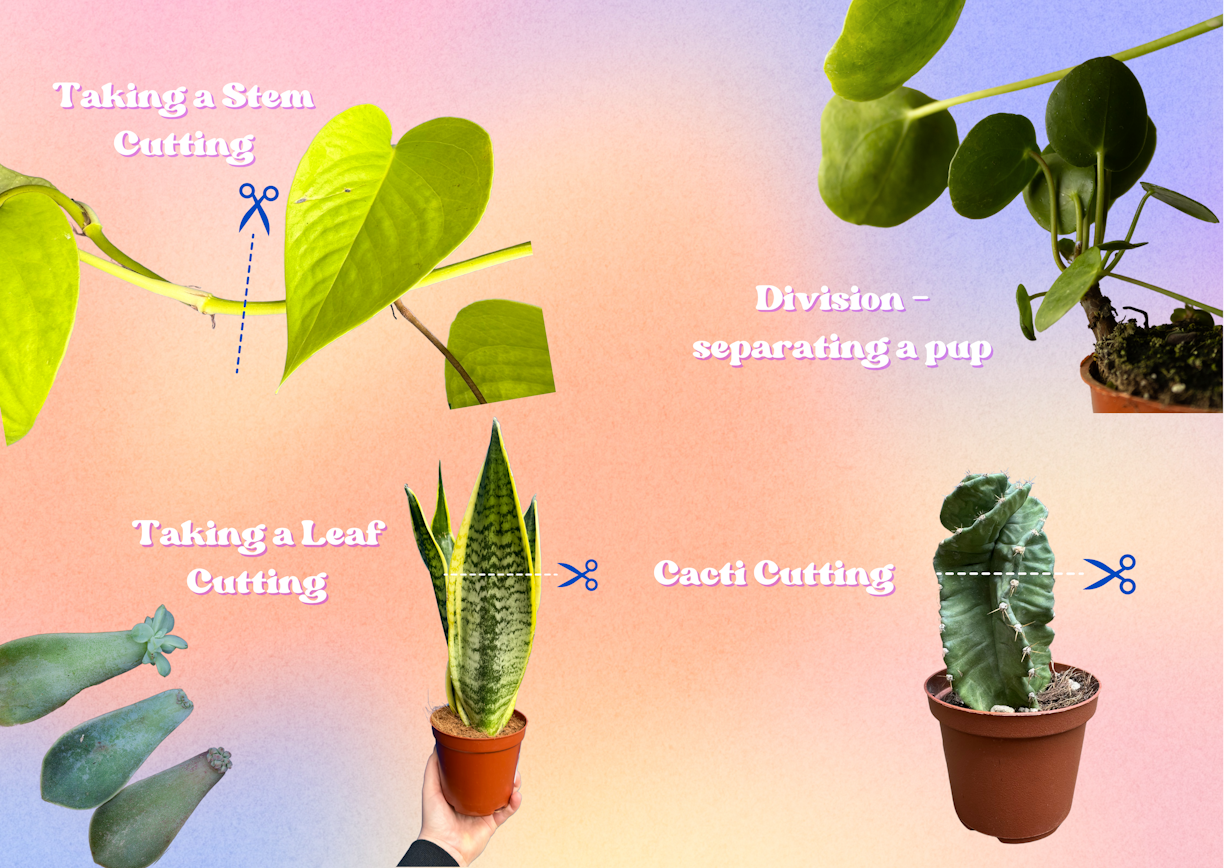
Types of Propagation:
So, you’ve got your cutting… What’s next? There are many ways to set up your new cutting so that it produces roots and becomes a plant of its own, and each is useful for different plants, but easily achievable at home.
Water: The most popular way to propagate cuttings is using water. Special kits can be obtained online that are designed to hold cuttings, but you can quite easily use an old drinks bottle or a glass jar. Fill it up to the top with water, and place the cutting in so that the roots, node or the end of the petiole is in contact with the water. Leave it in a spot that receives medium light and wait for roots to start growing! It is important to change the water every week or so to reduce algae growth. I prefer to change half the water at a time, so that I am not disposing of the useful growth hormones that the plant is putting into the water.
Moss: Using sustainably sourced sphagnum moss is a great way to propagate cuttings. It is a method that effectively stores water, without the risk of growing algae or having stagnant water sitting in the home. Further, it uses the anti fungal and bacterial benefits of mosses to the benefit of your cuttings! Use a see through or translucent container (such as a takeaway box) and put in a layer of moss. Mist the moss and then place in your cuttings. If you like, a second layer of moss can be placed on top to trap humidity, as long as the leaves of the cutting are still exposed to access light for photosynthesis.
Soil: Soil propagation is useful in multiple ways, and is recommended for cuttings that already have a decent amount of roots, such as pups and rooted rhizomes. These cuttings can be placed directly into soil and watered sparingly to produce a new plant. This method is also good for propagating cacti and succulents once they have calloused, as the soil helps to support their structure while the roots form. It may sound insane to some, but if you are propagating a cactus in soil, do not water it! It can root quite happily in dry conditions and water greatly increases the risk of rot.
Air: Air propagation is mainly for cacti and succulents that need to callous before producing roots. If they are in sufficient light and supported, they can usually produce roots in the air without any need for water or humidity. In order to ensure the plant roots in the right place, people often prop them up using a pot of perlite or stone, which allows oxygen to get to the root system while ensuring the plant is held in the right place.
How Do I Know My Cutting is Ready?
Frustratingly, there is no one way to know. The best way to be sure is to keep your eye on the roots. If the plant sits in water for too long, they can often become nutrient starved. This is remediable by adding certain nutrients to the water, but this can cause other problems like algae growth or pest harboring (and awful smells). As a good rule of thumb, I like to ensure that the root system is at least 2-3 inches and has multiple roots before I pot anything up. Others suggest that the root ball should be at least ⅓ of the size of the cutting it is growing from, which accounts for cuttings of different sizes. Sometimes, houseplants require a little bit of trial and error, but the results are worth it!
A Note on Seed Propagation
There is another method, which is infinitely more complex than the above. While each method listed above produces a genetic clone of the parent plant, seed propagation is a method that utilizes sexual reproduction to produce a new plant that has properties from both parents to produce a plant. In order to do this there are a lot of necessary components. Here is a brief list that should tell you where to start, and what you need:
- Ideal Conditions: Your plants need to be kept in the ideal conditions, mimicking their home environment as best as possible.
- Compatible Parents: Not just any two plants can be crossed, they have to be closely related enough to produce offspring, sometimes this is isolated to a single genus or species. Further, some plants produce male and female parts within themselves, some produce male and female flowers that can only be fertilized by a plant with different genes, and some plants are strictly male or female, and one of each is required to complete the process.
- Knowledge of the Plant: Plants have evolved in very different ways, in response to very unique conditions. This means that understanding the plant’s life cycle is the best way to understand how to replicate this at home. Even with successful pollination and compatible parents, certain conditions are still required to ensure success.
- Patience: For a lot of plants, this process can take months and a lot of meticulous inspection. It is by no means a quick and reliable process. Even in the wild, only a very small percentage of reproduction attempts are successful.
The method of acquiring seeds from your plants is very difficult, and is recommended for more experienced gardeners. However, the propagation side of things is accessible for most people! Seeds can easily be purchased online and often come with instructions regarding how best to care for them and get them started. It is an exciting project to get into and can often yield really interesting results! There are some really great beginner houseplants that can be grown from seed if you’re looking at giving it a go, I’d recommend: Coleus (Plectanthrus scutellarioides), certain species of Cactus, easy succulents such as Lithops, and delicate, fast growing perennials like Oxalis and Commelina.
Jonathan Davies
Jonny has worked at Root since May 2023. His love for plants was inherited initially from his grandparents and parents, but really took off once he moved into his own place, where he started picking up small plants and was fascinated by watching how they grow and change over time. Jonny has a degree in Archaeology and Classics from the University of Sheffield, and a masters in Egyptology from Swansea University, where he primarily focused on garden culture in the ancient world, which he has managed to extend to a PhD thesis in the University of Liverpool, where he has been able to combine his love for plants with his love for ancient language and culture. Jonny loves being in the natural spaces around North Wales and Cheshire where he used to go growing up, and often spends hours examining the plants and trees, and kicking up the leaf litter searching for mushrooms and insects. He is fascinated most by plant biology, taxonomy and learning about ecosystems and interactions between plants and their environmental counterparts, and enjoys tending to his varied array of houseplants, and ongoing ‘plant projects’, such as growing plants from seeds and creating living epiphyte displays. Aside from his green thumb, his other interests include: art, reading, listening to and playing music in the company of his cats, Spooky and Boo.
More by Jonathan DaviesRelated Articles
View all articles
